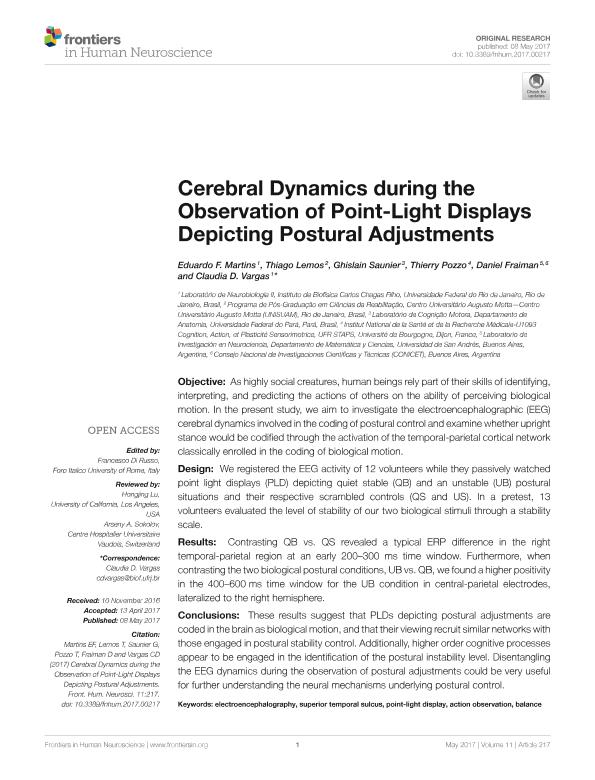Artículo
Cerebral dynamics during the observation of point-light displays depicting postural adjustments
Martins, Eduardo F.; Lemos, Thiago; Saunier, Ghislain; Pozzo, Thierry; Fraiman Borrazás, Daniel Edmundo ; Vargas, Claudia D.
; Vargas, Claudia D.
 ; Vargas, Claudia D.
; Vargas, Claudia D.
Fecha de publicación:
05/2017
Editorial:
Frontiers Research Foundation
Revista:
Frontiers In Human Neuroscience
ISSN:
1662-5161
Idioma:
Inglés
Tipo de recurso:
Artículo publicado
Clasificación temática:
Resumen
Objective: As highly social creatures, human beings rely part of their skills of identifying, interpreting, and predicting the actions of others on the ability of perceiving biological motion. In the present study, we aim to investigate the electroencephalographic (EEG) cerebral dynamics involved in the coding of postural control and examine whether upright stance would be codified through the activation of the temporal-parietal cortical network classically enrolled in the coding of biological motion. Design: We registered the EEG activity of 12 volunteers while they passively watched point light displays (PLD) depicting quiet stable (QB) and an unstable (UB) postural situations and their respective scrambled controls (QS and US). In a pretest, 13 volunteers evaluated the level of stability of our two biological stimuli through a stability scale. Results: Contrasting QB vs. QS revealed a typical ERP difference in the right temporal-parietal region at an early 200–300 ms time window. Furthermore, when contrasting the two biological postural conditions, UBvs. QB, we found a higher positivity in the 400–600 ms time window for the UB condition in central-parietal electrodes, lateralized to the right hemisphere. Conclusions: These results suggest that PLDs depicting postural adjustments are coded in the brain as biological motion, and that their viewing recruit similar networks with those engaged in postural stability control. Additionally, higher order cognitive processes appear to be engaged in the identification of the postural instability level. Disentangling the EEG dynamics during the observation of postural adjustments could be very useful for further understanding the neural mechanisms underlying postural control.
Archivos asociados
Licencia
Identificadores
Colecciones
Articulos(SEDE CENTRAL)
Articulos de SEDE CENTRAL
Articulos de SEDE CENTRAL
Citación
Martins, Eduardo F.; Lemos, Thiago; Saunier, Ghislain; Pozzo, Thierry; Fraiman Borrazás, Daniel Edmundo; et al.; Cerebral dynamics during the observation of point-light displays depicting postural adjustments; Frontiers Research Foundation; Frontiers In Human Neuroscience; 11; 5-2017; 1-12
Compartir
Altmétricas



